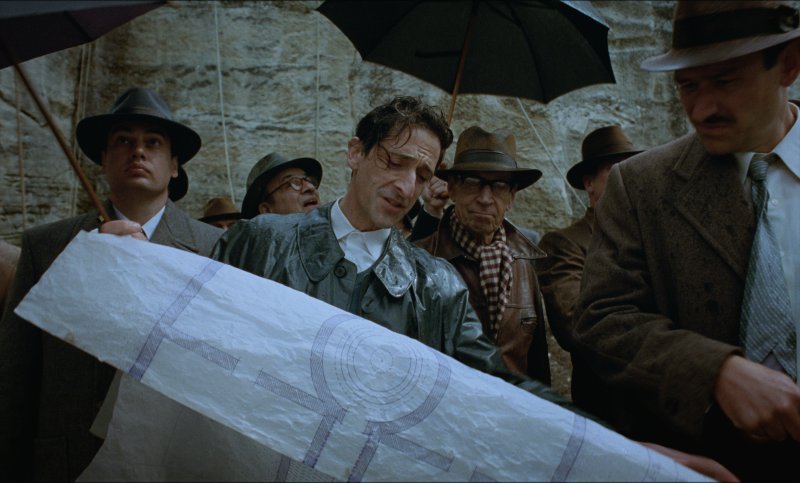The Brutalist Balances Beautiful Cinematography With Harsh Struggles of Immigrants


[This review has spoilers.]
The Brutalist is a 2024 film about visionary architect László Toth, a Hungarian-Jewish architect who survived the holocaust and immigrated to America. The film, which has a runtime of 3 hours 35 minutes and is split into two parts, is nominated for 10 Academy Awards, including Best Picture, Best Actor and Best Supporting Actress.
Part one of this film, which runs about an hour and 40 minutes, starts in 1947 with Toth’s arrival in New York and covers 5 years of his new life as an immigrant after he moved to Philadelphia. The film keeps you enraptured with Toth, played masterfully by Adrien Brody. Toth, a trained architect before the war, is shown living in a shelter because he came to America with no money, and he is having trouble finding a job. He became addicted to heroin, an afflicted that reflected the lives of many post-war immigrants who used hard drugs to get through the struggles they experienced.
Toth was first commissioned to renovate the library of a wealthy industrialist, and when his talent was recognized, a grand monument. With everything priced so low, Toth was getting paid next to nothing. In the film, the prices for buildings the characters discussed were cheaper than they would be today.
The first part offers some backstory on Toth and his wife and niece, who were in Europe, through the letters he and his wife wrote back and forth to each other. While the letters offered some insight, they mainly showed how they were doing in Europe and the steps that his wife, played by Felicity Jones, needed to take to get to America. The excerpts from the letters, while brief, help you understand the relationship he and his wife had.
Most of the filming was located in Budapest, Hungary, but the sound design and cinematography, on top of the choice of locations, made it seemed like the film was shot in mid-19th century Philadelphia and its suburbs. The verisimilitude is helped by the simulation of radio broadcast from that time period about living in Pennsylvania and how much PA steel had done and been used in the rest of America. These captured what life was like in the late 40s and 50s in America, especially for immigrants.
Part of my issue with this half of the film is that it jammed a lot of the plot into that 100 minutes. It skipped ahead at some points while dragged at other points that could have been cut to make the runtime shorter.
Part Two of this film is heavier and focuses on much harder topics, some of which people may find uncomfortable. It starts with Toth picking up his wife and niece from the train station in Philadelphia. If you were expecting the movie to become happier now that his family was with him, you would be shocked. Due to the war, his wife was in a wheelchair and his niece was unable to speak.
Throughout this entire section of the film, Toth and his family were treated horribly. Toth was told that nobody wanted him or his family there, and that they were tolerated because he was building something for them. It was implied that his niece was sexually assaulted, and Toth himself was shown being raped. This section of the film covers heavy subject matter, but it also feels like it dragged on with a very confusing and bad conclusion.
The film ends with an epilogue thaat shows an exhibition in Venice of Toth’s life works. He is older and his wife has passed, so his niece gives a speech, which ends with the message, “it is the destination, not the journey.”
After everything that this movie makes you go through and watch him suffer, this seems like a weird ending.
The acting in this film is 9 out of 10. Adrien Brody is giving one of his best performances, even if I feel the accent he is doing is not accurate. Guy Pearce, who plays the industrialist, is a great antagonist in this film who really makes you feel like he hates Toth. Pearce is nominated for Best Supporting Actor. Felicity Jones, nominated for Best Supporting Actress, might just be one of the best actors in this film, despite the very little screen time she had. She makes you believe that she had been through the war, and that every single event she witnessed was affecting her.
I don’t think that this film has a soundtrack or if it does, it isn’t very noticeable. I think that this is a good thing though as I feel like music would detract from the events and not having one makes this film feel more real and more haunting. The sound design is one of the best parts. The film clearly cares about which sounds to use because nothing was out of place and every sound fit and made you feel like you were in the location, whether it was the city or the country. The cinematography is also good. The way they shot locations was beautiful. The whole movie has a sort of film grain to it that makes it seem like a documentary.
At 3-1/2 hours though, this film is too long. There is quite a lot that can be cut to make a 2-1/2 hour film while keeping the same message.
Overall, The Brutalist is a great telling of what it was like in post-war America for immigrants while having some great acting and beautiful shots. This film would be one of the best of last year's crop if it was a little shorter. I give this film a 7 out of 10.









